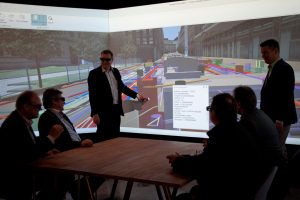The project aims to develop an integrated decision support platform to assess different pilot cases of Multimodal, Multiproduct and Multipurpose Freight Rail Terminals in terms of a wide range of Key Performance Indicators (KPIs) and Key Risk Indicators (KRIs). By integrating simulation modules of the terminal operation and its relationship to the hinterland into a BIM design, both the quickness and the quality of the decision-making will be improved.
The main objectives of the INTERMODEL are:
- To improve decision making in multimodal freight terminal networks and supply cha To assess and evaluate the design alternatives of a Virtual Terminal in comparison to the improvement of a Real Terminal in terms of the outputs of an underlying BIM – Building Information Modelling – virtual design.
- To develop an advanced ICT planning environment based on BIM methodology adapted to intermodal freight rail terminals in order to support decision-making regarding both design and planning as well as operating phases through the whole life-cycle.
- To reduce the operational burden of the intermodal terminal on the surrounding area and on the existing logistics network regarding functional, economic and environmental dimensions, thus improving citizen’s quality of life.
This will be achieved by integrating simulation modules of the terminal operation and its relationship to the surroundings in a Building Information Modelling (BIM) design. Which will significantly improve quickness and the quality of the decision-making. To achieve this goal, we propose to develop an advanced ICT environment based on BIM methodology adapted to intermodal freight rail terminals in order to support decision-making regarding both design and planning as well as operating phases through the whole life-cycle of the terminal. The ICT environment will include a BIM design able to interact with several simulation tools of the terminal performance and its outside impacts. This integral approach will consider static and dynamic indicators such as CAPEX (Capital expenditures), OPEX (Operational expenditures), maintenance scheduling, costs, energy efficiency, productivity, capacity, reliability and environmental impacts.

